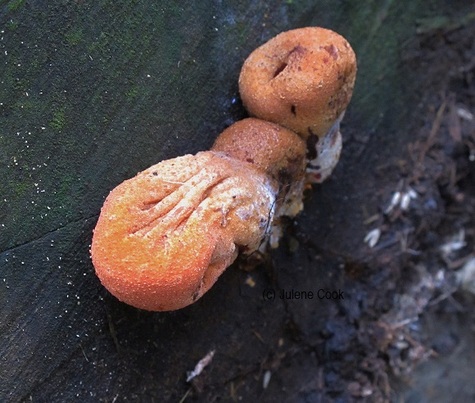 Unidentified Australian puff-ball fungi
Unidentified Australian puff-ball fungi | | |
| FungiOz - Australian fungi & more |
Copyright (2014)
|
 Unidentified Australian puff-ball fungi Unidentified Australian puff-ball fungi These unidentified puff-balls were found growing on a huge log, possibly beech, in early winter. The colour was a very deep orange, quite unlike the usual Lycoperdon fungi. They appear to have short thick, white stalks and white spores that can be seen on the surface of the lower fungi. Notice how wrinkled the lower putt-ball is, yet it does not seem to have released any spores as yet.
2 Comments
Lepista nuda, known as the wood blewit mushroom, is a choice edible mushroom providing it is very well cooked. It is regarded as having been introduced to Australia. Lepista nuda is a reasonably substantial mushroom with palish purple cap, stem and gills. The nuda part of its scientific name refers to the mushroom's totally smooth cap. However, those tempted to try eating Lepista nuda had better be sure that they haven't got the poisonous Australian mushroom, Cortinanus archeri, in the pan. Can you tell which of these two mushrooms is edible and which is the poisonous look-a-like? The colour of the two can be very similar especially in dry weather. Both start out as quite purple and fade to buff colour over time. Both have smooth cap surfaces that look similar when dry and both appear ringless. Stem Differences 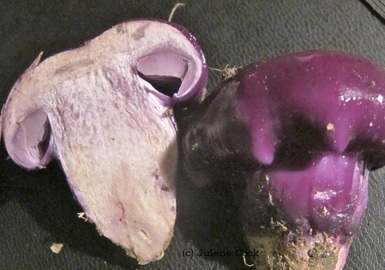 Young Cortinarius archeri Young Cortinarius archeri Similarities & Differences when young. Both mushrooms begin with a fairly swollen base and convex cap and both have solid pale lilac tinged flesh. Being a Cortinarius, archeri's cap is initially attached to the stem via a web known as a cortina. However, as shown in this photo of a young Cortinarius archeri, the web can easily be mistaken for a ring. Smell. The edible Lepista nuda has a lovely sweet and strong smell all of its own. Cortinarius archeri has no smell. Spore Print colour: The spores of Cortinarius archeri are copious and rust coloured whereas the spore print of Lepista nuda is a pinkish buff colour. A last warning. Before deciding to cook up a mushroom you have decided is Lepista nuda, keep in mind that if it is not very well cooked it will have toxins that can damage red blood cells. So, the wisest choice is look, smell, enjoy but don't eat.
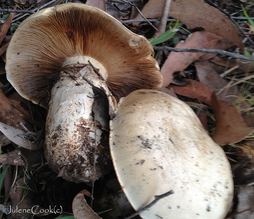 The Poisonous Cortinarius australiensis can look quite like an edible horse mushroom. The Poisonous Cortinarius australiensis can look quite like an edible horse mushroom. However, in Australia foragers should take care not to confuse it with the large and poisonous Cortinarius australiensis. From a distance they look very similar. Both are
How to tell the difference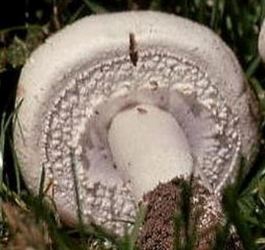 If the mushroom is young start by inspecting the unbroken ring. The horse mushroom has a kind of cogwheel ring as shown in this photo. This partial veil is distinctive enough but the inner spokes are fine and web-like like a cortina. 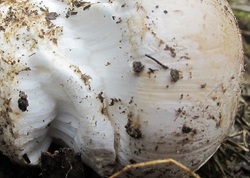 Close up showing the ring of Cortinarius australiensis to be a cortina Close up showing the ring of Cortinarius australiensis to be a cortina The picture to the left identifies the ring of the actual poisonous mushroom as a rather thick cortina that extends over the whole cap from low on the stem. However, the cortina threads are so thick that they look more like an agaricus veil. 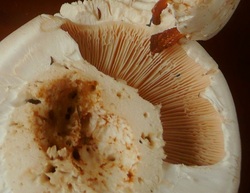 The gills of the poisonous look-alike are initially very pale mustard and darken to a distinct rust brown due to the typical rust coloured spores of Cortinarius mushrooms. The specimen in this photo shows both a section of newly exposed, pale mustard gills. Notice in this photo how much the still attached parts of the cortina looks like an agaricus ring rather than the usual fine threads a Cortinarius web. However, the gill colour identifies this mushroom as a Cortinarius. Differences in the mature mushroom The photo on the left below shows a mature Cortinarius australiensis mushroom. Here, the gill colour could be mistaken for those of the horse mushroom pictured on the right. However, the Cortinarius gills are more rusty than the Agaricus gills and the real give-away is the distinctly rust coloured spore stain on the stem of the Cortinarius. Notice also the chiselled shape of the Cortinarius base. The gills of the horse mushroom are chocolate brown even at this fairly early stage. Notice also how much longer the stem is in the horse mushroom. In conclusion, if this comparison makes you rather more wary about any "horse mushroom" you might throw in the pan, it is probably a good thing. These two species can look very alike.
This mushroom has been extensively used in Asian medicine for 2000 years. In Asia it is known as the lingzhi or reishi mushroom. It is regarded as "the mushroom of immortality" and is used as a symbol of longevity on Chinese ceramics . Reishi comes from the Chinese name ruizhi 瑞芝 which means "auspicious mushroom". Both Chinese Ling and Zhi have multiple meanings so Lingzhi has English translations that include, Possessed of soul power, Herb of Spiritual Potency or Mushroom of Immortality, Numinous or divine mushroom, Magic Fungus and Marvelous Fungus.
A Translation of the Divine Farmer's Materia Medica, a Chinese book written down between 200 and 300 BC said the reishi mushroom "mainly treats binding in the chest, boosts the heart qi, supplements the center, sharpens the wits, and [causes people] not to forget. Protracted taking may make the body light, prevent senility, and prolong life so as to make one an immortal. Western science has studied Ganoderma Lucidum species extensively and found they contain approximately 400 different bioactive compounds and a very wide range of medical effects. The list is astounding. Ganoderma Lucidum has been found to:
Description: Ganoderma Lucidum is a polypore mushroom that is soft (when fresh), corky, and flat, with a conspicuous red-varnished, kidney-shaped cap with white to dull brown pores underneath. Where it is found: Ganoderma Lucidum is found worldwide in both tropical and temperate climates. It is a parasite that causes white rot on the many types of trees on which it grows at their base. However, it is extremely rare in the wild, only being found on old trees and on only two or three out of 10,000 of these. As early as the Liang Dynasty 502-587 the Chinese were growing national mushrooms, as demonstrated by an illustrated text of that period, called Zhong Shenzhi 種神芝 "On the Planting and Cultivation of Magic Mushrooms". Supplies today are cultivated both indoors and outdoors on logs or woodchip beds. Growing gourmet and Medicinal mushrooms by Mycologist Paul Stammets, tells you how. How it is prepared: Thinly sliced, finely chopped or powdered fresh or dried reishi is added to a lidded pot of boiling water and simmered for two hours or more, yielding a very bitter and dark liquid which is drunk. Supplements: These days Reishi extract can be taken as a capsule available from Fungi Health. Further reading
|
Australian FungiAustralia is estimated to have 200,000 fungi species compared with only 6,000 European. However, only about 12,000 Australian mushrooms have been identified with about 6,000 named and described. This website and Fungioz app are dedicated to increasing knowledge of both known and unidentified Australian mushrooms.
Archives
December 2014
Categories
All
About MeI am not a mycologist but have been fascinated by fungi since childhood sheep farm forays.. After moving to the northern edge of Australia's Otways National park I realised how many more wonderful species there are on uncultivated land.. I began photographing and researching and now sharing the ongoing results via FungiOz website and FungiOz app. Fungi identification via field characteristics alone is tentative as are any suggested identifications in FungiOz app and website. |